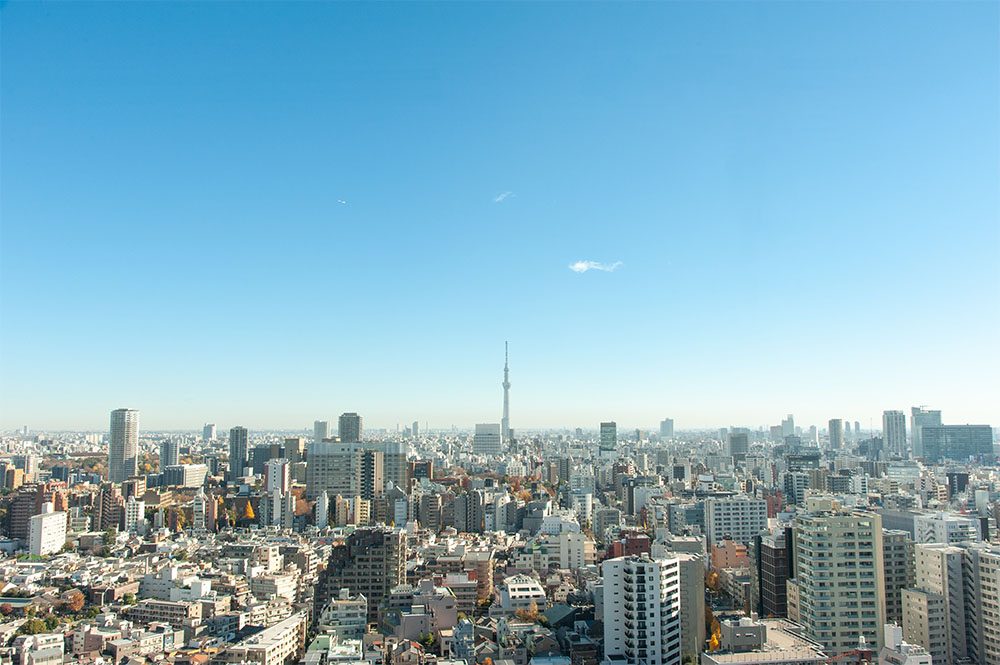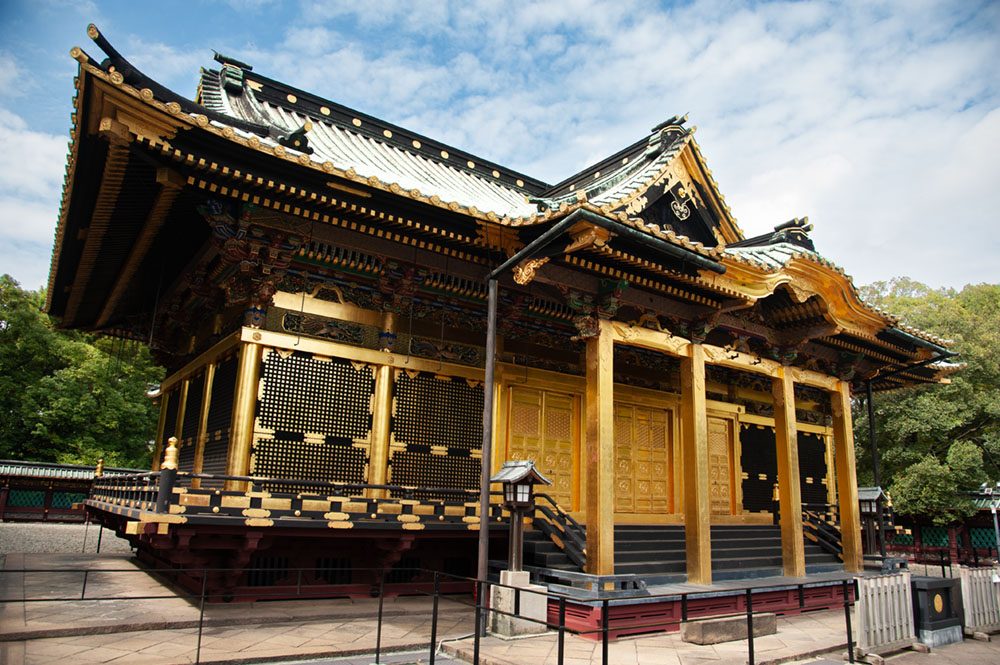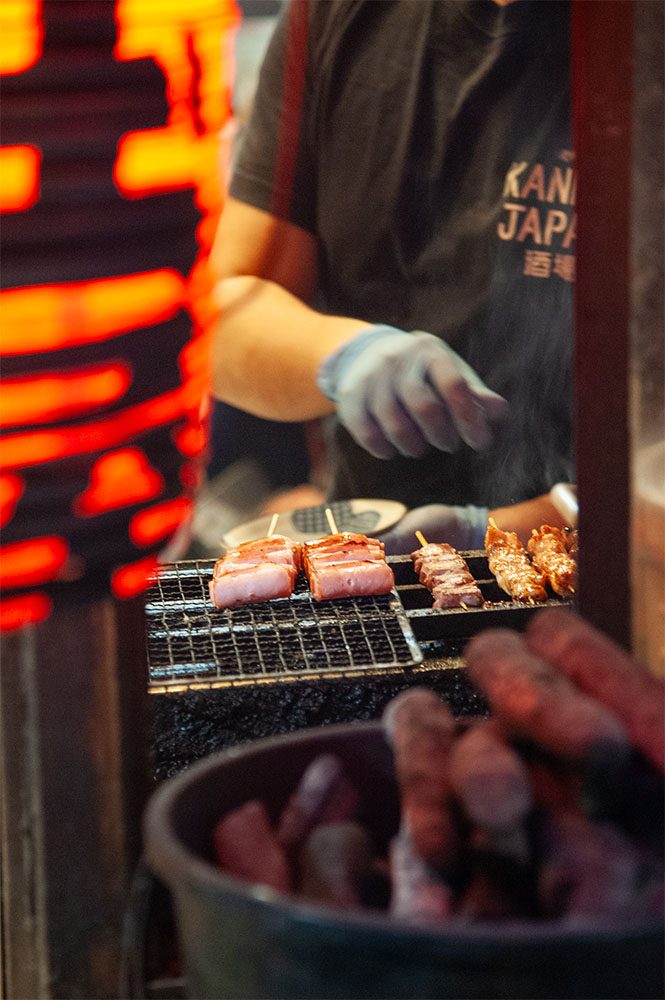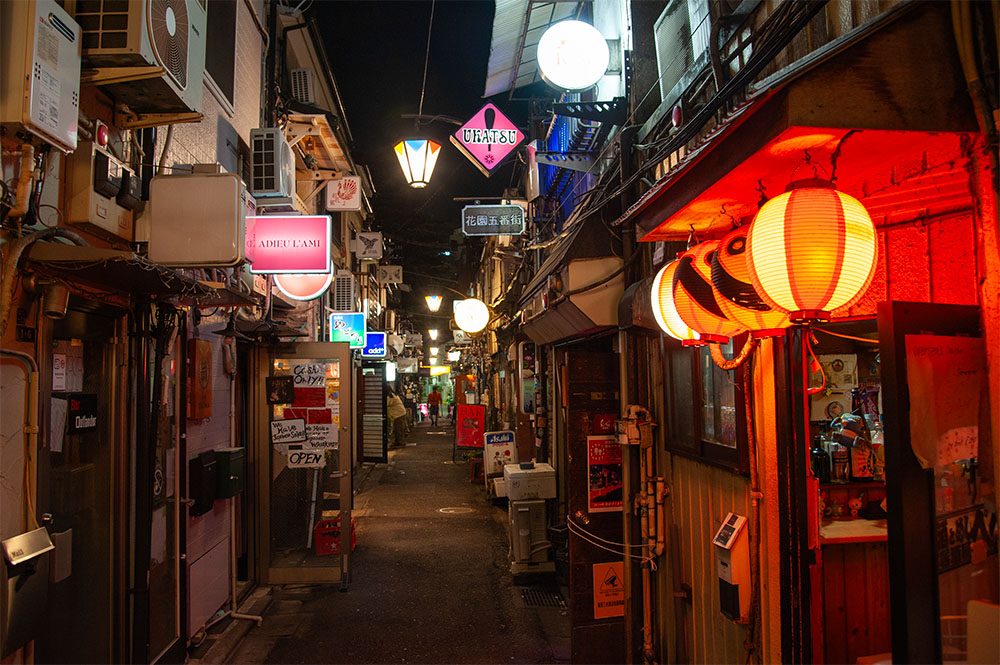Home / Destinations / Japan / The Perfect Tokyo 2 Day Itinerary

By James Davies in Japan Guides.
A total of two days in Tokyo might not feel like enough time to do this gargantuan city justice.
However, if you are planning on a spending 48 hours in Tokyo, you’ll be surprised at just how much you’ll be able to see. Follow our two day Tokyo itinerary for the perfect introduction to one of the world’s most fascinating and frenetic cities.
We have structured our two day Tokyo itinerary so that you can get the most out of the time that you have in the city.
The capital of Japan is the largest city in the world there’s enough to see and do in Tokyo to last several lifetimes. If you only have two days in Tokyo you’ll have to use your time carefully.
For that reason we’ve compiled our itinerary so that the sites listed on each day are relatively near to each other, or at least within easy reach of each other.
This cuts down on the amount of time you spend travelling across the city, which you can instead spend seeing more of Tokyo.
Here’s a quick overview of our 48 hour Tokyo itinerary, along with a map of all of the main spots we’ll visit.
On the map, the green markers denote locations on day 1, while blue markers are for day 2.
Day 1:
Day 2:
Tokyo - A Couple of things to Know Before You Go
• While Tokyo is a year-round destination, the best time to visit is either spring or autumn. Find out why in our post on the best time to visit Tokyo here.
• You can save time by buying advanced entry tickets to a lot of Tokyo’s attractions, as well as book guided tours, transfers, and more on sites such as Get Your Guide, Viator and Klook.
Get Your Guide and Viator are both great for booking experiences such as walking tours and sumo training sessions, while Klook has the best range of entry tickets to Tokyo’s major attractions as well as travel passes, including the Japan Rail Pass.
At the end of this post we’ll discuss the best area to stay during your two day trip to Tokyo, as well as how to get around the city.
But for now, let’s get straight in to the best things to see and do in two days in Tokyo.

Start your two day Tokyo trip in Ueno and head straight for Ueno Park.
Ueno Park is a vast green space that is filled with world-class museums and stunning temples and shrines. The park is also one of the most popular cherry blossom viewing spots in the spring.
Within yards of each other are the Tokyo National Museum, the Ueno Royal Museum, the National Museum of Western Art and the Tokyo Museum of Metropolitan Art all feature excellent exhibitions all year round.
Meanwhile, the National Museum of Nature and Science is great for those travelling with kids.
If you’d prefer something a little cuter then pop into to see Ri Ri and Shin Shin, the two resident pandas at Ueno Zoo. The oldest zoo in Japan, there are over 2,500 animals at Ueno Zoo including bears, elephants, lions and tigers. Entry is only ¥600.
Also in Ueno Park are several small but beautiful temples and shrines. The dazzling gold-leaf Ueno Toshogu Shrine was built in 1627 to honour Tokugawa Ieyasu, one of Japan’s most important shoguns. Nearby, a pathway lined with picturesque vermillion torii gates leads the way to Hanazono Inari Shrine.
Don’t miss Shinobazu-no-ike Bentendo temple, which sits on an island surrounded by the beautiful Shinobazu Pond. You can also hire swan-shaped peddle-boats if you fancy a sail across the pond.

From Ueno, make the short trip to Asakusa to see Sensoji Temple.
Colourful Sensoji Temple is the oldest temple in Tokyo, having been established in 628 and is one of the city’s most iconic landmarks. Most of the current buildings were restored following the Second World War.
At the main entrance of Sensoji is Kaminarimon Gate, where the imposing statues of the gods of wind and thunder stand guard beside an enormous hanging lantern.
Behind Kaminarimon Gate, take a walk along Nakamise Dori, a long street of stalls and shops that specialise in local souvenirs and traditional snacks.
At the far end of Nakamise Dori is Sensoji Temple’s second and larger gate, the Hozomon gate and to its left the temple’s five-storey pagoda.
Just beyond the Hozomon gate is Sensoji’s spectacular main hall, where another huge lantern hangs over a large incense burner.


Next, make your way across the Sumida River to the Tokyo Skytree for arguably the best views of the city.
As the world’s tallest tower, the views from Tokyo Skytree’s observation deck are nothing short of breathtaking.
At 634 meters high, you can see every corner of Tokyo and well beyond – on clear days you can easily catch a glimpse of Mount Fuji. From here you can get a sense of the sheer size and scale of Tokyo.
There are actually two viewing platforms inside the Tokyo Skytree, the Tembo Deck on the 350th floor, and the Tembo Galleria on the 450th floor.
It’s an extra ¥1000 to visit the Tembo Galleria. If you’re looking to keep costs down, then the view from the Tembo Deck are spectacular enough to satisfy most people.
• You can skip the queues and buy advance tickets for the Tokyo Skytree here.

After the Skytree, it’s a 25 minute journey by subway south to Tsukiji Outer Market. Tokyo is a food-lover’s paradise, and there’s no better place to sample some of the city’s freshest seafood than at Tsukiji’s Outer Market.
Even though Tsukuji’s main fish market (home to the famous 4:00am tuna auctions) relocated to Toyosu in Tokyo Bay in 2018, Tsukiji’s long standing Outer Market – packed with shops selling fresh produce, seafood stalls and restaurants – still remains.
The restaurants at Tsukiji’s Outer Market are still supplied by the same fishmongers who have relocated to Toyosu. Stalls and restaurants open early each morning, at around 5.00am, serving up mouthwatering plates of sushi, sashimi, donburi and eel.
Take a wander around the outer market’s narrow lanes of shops and stalls before sitting down for a seafood lunch of your choice.
• If you want to sample some of the finest seafood and sakes in Tsukiji whilst learning more about the area’s history, then this guided tour of the Outer Market is essential.


From Tsukiji, walk to Shintomicho Station to get the Yurakucho Line to teamLab Planets Tokyo.
One of the most popular attractions in Tokyo, teamLab Planets Tokyo is the phenomenally successful exhibition of digital artworks located in Tokyo Bay.
The varied and incredibly inventive exhibitions created by the teamLab Planets collective of digital artists make for a wonderful few hours.
Each room offers a different range of wildly different experiences. Artworks range from fabulously colourful displays of light, mesmerising floral projections and immersive and interactive works featuring images of fish projected onto water.
• Skip the long queues and buy advance tickets for teamLab Planets here.


After teamLabs Planets, make your way back into the heart of the city and end the first of your two days in Tokyo in Shibuya.
As soon as you exit Shibuya Station you will be met by one of Tokyo’s most famous sights, the Shibuya scramble crossing. It’s estimated that up to 3,000 people cross the famous crossing in every direction each time the lights turn red.
Nearby is the statue of Hachiko, a Japanese legend who has become a symbol of loyalty and faithfulness.
The statue of Hachiko honours a real dog who would dutifully meet his owner at Shibuya station every day. Hachiko continued to wait at the same time each day for years after his owners death, becoming an unlikely national celebrity.
Today the statue of Hachiko is a popular meeting spot as well as a local landmark.

If you’re craving another stunning view of Tokyo, then make your way to the Shibuya Sky viewing platform at the top of the Shibuya Scramble Square skyscraper for a different perspective of the city.
Shibuya Scramble Square’s open air viewing deck offers sensational views from high up right in the heart of Tokyo. The views are particularly spectacular at sunset and as the city begins to light up at night.

Afterwards, take a walk along Shibuya Center Gai, Shibuya’s touristy main street. An illuminated explosion of colour after nightfall, Shibuya Center Gai and the neighbouring streets are crammed with shops, restaurants and bars.
From Center Gai, walk up to Miyashita Park, a modern shopping and dining complex that sits next to the train tracks of the Yamanote Line.
As well as a number of great stores, and an open air park on the top floor, Miyashita Park is also filled with a huge choice of excellent restaurants and bars.
On the ground floor are a number of restaurants that specialise in cuisine from all over Japan. Up on the higher floors there are also a number of international restaurants, making this is the perfect place to end the first of your two days in Tokyo.


Start the second day of your two day Tokyo itinerary with a contemplative walk to Meiji Jingu Shrine. Hidden inside a vast forest of trees, the Meiji Shrine is one of the most sacred shrines in the city.
The Shinto shrine was built to honour Emperor Meiji and his wife, the Empress Shoken. Under the rule of the Emperor and Empress, Japan transformed from an isolated nation to a major world power.
The serene walk through the forest to the shrine passes through several huge torii gates and past a wall of sake barrels. The barrels are donated by sake breweries from all over Japan to be used in Shinto ceremonies at the shrine throughout the year.
At the centre of Meiji Shrine stands the elegant main hall, which is reached via an imposing central gate. The shrine is also surrounded by several walking paths that lead through the forest’s towering trees.
Also within the forest is the Meiji Jingu Gyoen, whose beautiful iris garden is usually in full bloom between May and late June each year.

Almost directly opposite the entrance to the Meiji Jingu Shrine is Harajuku.
Another of Tokyo’s most famous areas, Harajuku mixes Japanese youth culture, street fashion, as well as a small dose of traditional Japanese culture.
Directly opposite Harajuku’s recently renovated station is its most famous street, Takeshita-dori.
Wander along the vibrant Takeshita-dori, famous for it’s fabulously kawaii cafes, crepe stalls and many J-pop inspired clothing stores.
Then stroll along the more mature and sophisticated Omotesando, home to countless high end fashion boutiques.
Also take a walk along Cat Street, the winding road that snakes across both sides of Omotesando. Alongside a warren of neighbouring backstreets, Cat Street is lined with chic vintage clothes stores, upmarket trendy fashion shops and bijou cafes.
If you fancy a spot of culture, call in to the Ōta Memorial Museum of Art, which houses an incredible collection of iconic Japanese woodblock prints by the likes of Hokusai, Hiroshige and many more.
If you get peckish then Harajuku is also a great place to eat.
For a lightish lunch pick up a sandwich at Harry’s Sandwich Company tucked away down a tiny lane behind Cat Street, or a plate of delicious waffles at Noa Coffee on Takeshita dori.
The best ramen in Harajuku can be found at Oreryu Shio Ramen Jingu-mae or there’s Heiroku Sushi for good value conveyor belt sushi.
If you’re after something a bit more kawaii and Harajuku then head to Pompompurin Cafe for meals and desserts shaped as cartoon characters.

From Harajuku station take the Yamanote Line two stops north to spend time exploring Shinjuku.
Synonymous with shopping, eating and having a good time, Shinjuku is the downtown area of skyscrapers, neon-lit shopping streets and atmospheric narrow alleys that comes to mind when most people think of Tokyo.
Home to the world’s busiest train station and packed with restaurants, shops, cafes, bars and so much more, Shinjuku is one of Tokyo’s most frenetic and fun-filled districts.
If you want to spend some yen then hit the stores on Meiji-dori. You can also shop till you drop in huge department stores such as Takashimaya or Isetan Shinjuku.
If you’re in the mood for a bit of art, visit the SOMPO Museum of Art, which features a varied collection of Japanese and Western art, including Van Gogh’s Sunflowers.

To the southeast of Shinjuku Station is Shinjuku Gyoen National Garden. A huge green oasis, the garden is a world away from Shinjuku’s high rise tower blocks, bars and neon.
The garden has a number of different areas and styles. The traditional landscaped Japanese garden features picturesque lakes and teahouses. Other parts of the garden include wild forested areas as well as a rose garden.
During the spring the garden is a hugely popular hanami spot, thanks to the hundreds of cherry blossom trees, while in autumn many of the trees turn a stunning range of orange and red.

After the serenity of the garden, head back into the urban jungle of Kabukicho in the heart of Shinjuku. Look up to the rooftops to see the angry head of Godzilla roaring above the Toho Cinema next to the Gracery Hotel.
Godzilla is the creation of Toho, a famous Japanese film studio who made the first Godzilla film in 1954. The 80 ton and 12 metre tall Godzilla head was unveiled in 2015, and has quickly become one of Tokyo’s most iconic landmarks.
For an even closer view of the monster, visit the Café Terrace Bonjou in the lobby of the Gracery Hotel. The cafe’s outdoor deck sits right beneath Godzilla’s snarling head.


When you start to get hungry you’ll be faced with a truly endless amount of options for places to eat. There are more than enough restaurants in Shinjuku to feed anyone for a lifetime.
You could try any of the huge range of restaurants inside Tokyo’s latest landmark, the Kabukicho Tower. But if you want to eat where the locals eat, head straight to Omiode Yokocho, the historic narrow alley underneath the train tracks that is lined with tiny restaurants that’s often referred to as either Memory Lane or Piss Alley.
Many of the restaurants along Omiode Yokocho are little more than stalls with a counter and just a handful of seats. Some restaurants are for locals only and can be a bit sneery towards tourists, yet many are very welcoming and even have English menus.
The atmosphere inside Omiode Yokocho’s tiny bars is often boisterous, boozy and a lot of fun, making Omiode Yokocho a great place to experience Tokyo’s after work vibe.

If you’ve still got any energy left in the tank afterwards, wander over to Golden Gai, a collection of tiny streets packed with a multitude of minuscule bars.
Most of the bars of Golden Gai are all so small that they can only accommodate a handful of guests at a time, and many make Omiode Yokocho look like the height of sophistication.
Again a few of the bars are openly disdainful of tourists and for regulars only – it’s best to avoid anywhere with a ‘members only’ sign on the door.
Yet plenty of others, such as Araku, Bon’s American Bar, Champion and Kenzo’s are extremely welcoming and will provide a wonderful end to your two days in Tokyo. Kanpai!
• If you’d like to take a curated pub-crawl around Omiode Yokocho and Golden Gai then this is the tour for you. Led by an incredibly knowledgable local guide, you can enjoy drinks with the wonderful atmosphere of some of the best bars in Shinjuku.
👉 Need even more ideas and inspiration for the perfect trip to Tokyo? Then check out our seven day Tokyo itinerary here.
If you’re only spending two days in Tokyo we’re going to assume that your trip will either be at the beginning or the end of longer stay in Japan.
If this is the case, you’ll need to stay somewhere that is convenient for getting around Tokyo but also has good access to a Shinkansen station or whichever of Tokyo’s two airports you’ll be departing from.
For these reasons we’d recommend staying near one of the stations between Tokyo and Ueno Stations on the western side of the Yamanote Line, such as Kanda, Akihabara, and Okachimachi JR stations.
All of these stations are on the Yamanote Line, plus there are several subway stations nearby that are perfect for exploring the rest of Tokyo.
These stations are also great for getting the Shinkansen from Tokyo with direct access to Tokyo Station.
If you’re leaving Japan after your two day stay in Tokyo, then these stations also perfect for travelling to both of Tokyo’s international airports.
These stations all have direct access to Ueno Station, which has the quickest and easiest journey to Narita International Airport via the high-speed Keisei Skyliner from Keisei Ueno Station, located next to the JR Ueno Station.
If you need to get to Haneda Airport, you can take a direct train on the Yamanote Line to Hamamatsucho Station for the Tokyo Monorail. The journey from Hamamatsucho Station to Haneda Airport on the Tokyo Monorail takes only 15 minutes.
If you need a few suggestions here are a few places that we recommend:
Affordable
• Sakura Cross Hotel Akihabara – If you’re looking to keep an eye on costs then the 2 star Sakura Cross Hotel Akihabara is an excellent stylish yet cost-effective option close to Akihabara.
Next Level
• JR-East Hotel Mets Akihabara – If you’d prefer a mid-range option, the JR-East Hotel Mets Akihabara is a great modern hotel right next door to Akihabara Station.
Top of the Range
• The Tokyo Station Hotel – For a more luxurious stay, check into the lavish Tokyo Station Hotel and have the whole city on your doorstep.
Alternatively, you can search for the perfect accommodation for your stay in Tokyo here.
The easiest way to get around Tokyo is by train.
There are hundreds of train stations in Tokyo, all connected to dozens of overland and underground train lines, offering the quickest and cheapest way of getting around the city.
While taxis are always an option, the size and scale of Tokyo mean that getting from A to B by train is almost always the easiest and most affordable way.
The Google Maps app is the easiest way to navigate your way around the city. You can search for your destination in the app and easily find directions via public transport.
The Google Maps app also tells you other important information, such as which exits you’ll need to take from stations, or how long it takes to transfer between subway lines, for example.
You will need a data connection to be able to access Google Maps, so pick up a portable WiFi router or an eSim so that you can get online while you’re in Tokyo.
By far the easiest way to get around Tokyo is by picking up a PASMO or Suica IC card.
IC cards are travel cards that use pre-paid credit that can be used to tap in and out of train and subway stations in Tokyo. IC cards can also be used to pay for journeys on buses too.
Pasmo and Suica cards can easily be bought from ticket machines at train and metro stations in Tokyo. The cards are essentially identical, but they are made by different transport companies.
You can also buy a Suica card preloaded with ¥1,500 worth of credit online here.
When you need to add more credit on to the card you can do so easily at ticket machines in any train or subway station. Instructions are given in English on the ticket machines.
Both Suica and Pasmo cards can be used on any transport system in Japan that uses IC cards – from the trams in Sapporo to the subways and buses of Osaka.
This means that you can take your Suica or Pasmo with you and use it wherever you’re going next if you’re travelling to another part of Japan after your two days in Tokyo.
I’m James, the founder, editor, writer and photographer at Where You’re Between. Currently based in Japan, I started Where You’re Between in 2017 to create detailed itineraries and in-depth travel guides for the places that I’m fortunate enough to visit. You can see all of our destinations here.
If you’ve liked this post please share it on the socials:
Follow our travels on Instagram here, and keep up to date with our latest posts on Facebook here.

Please note that this post contains some affiliate links. If you click these links and go on to make a purchase we will earn a small commission at no extra cost to you.
© WhereYoureBetween.com – 2025
Cookies help us deliver our services – by continuing to browse this site, you agree to our use of cookies.
There's a World Out There. Let's Go!
Sign up to our email newsletter to get an occasional dose of wanderlust sent straight to your inbox